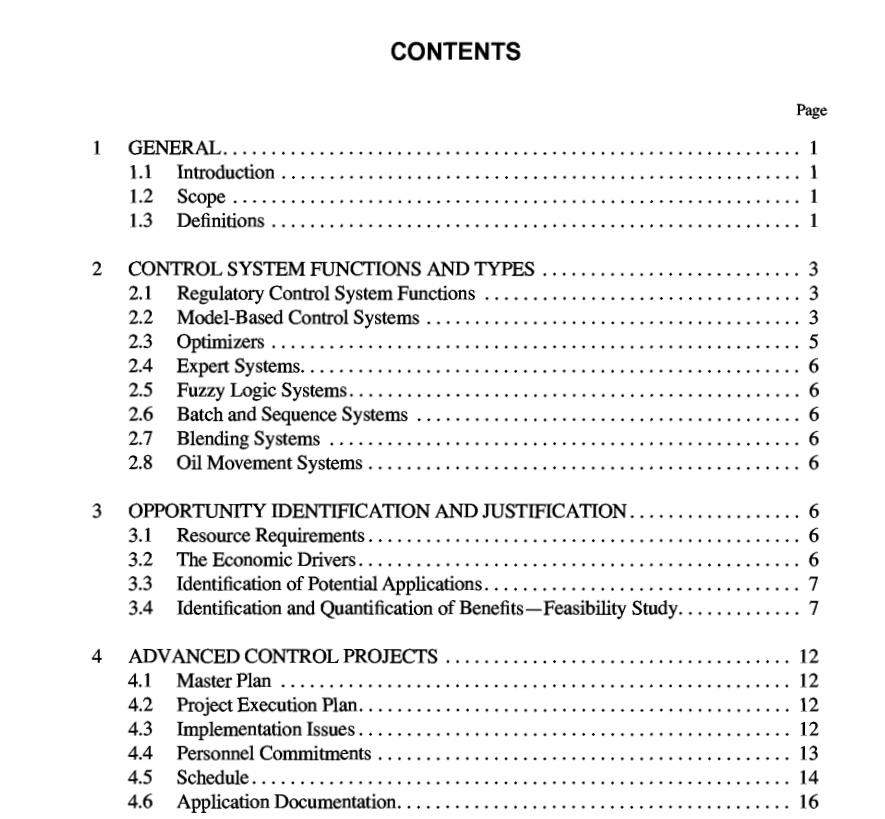API RP 557 pdf download

API RP 557 pdf download.Guide To Advanced Control Systems
1 General
1.1 INTRODUCTION This recommended practice addresses the implementation and ownership of advanced control systems for refinery pur- poses. The major sections of this recommended practice are described below. Figure 1.1 illustrates the major functions involved in the efficient and economic operation of a refinery and shows where advanced control fits into this scheme. Advanced con- trol systems form a fundamental building block on which many of the other functions depend. 1.2 SCOPE This recommended practice describes commonly used practices for the opportunity identification, justification, project management, implementation and maintenance of advanced control system applications in refinery services. This practice is not intended to specify the use or selection of any particular technique over another, nor is intended to describe specific applications. It may be used as the basis for defining the work processes and common functions required to define, implement and maintain advanced control system applications. The practices described in this document are applicable to all advanced control system applications. Users who are experienced in advanced control may have developed their own equivalent practices. This document is not intended to supersede user practices that have been found to be accept- able or to require that the practices described in this document be followed if they are not appropriate to the circumstance. Selection of a specific hardware platform, software plat- form or application software is not within the scope of this recommended practice. 1.2.4 Technology Considerations The technical issues that should be considered in selecting advanced control system hardware and software are described in Section 5. 1.2.5 Design Considerations Application design features needed to support control functions, operator interfaces and engineer interfaces are described in Section 6. 1.2.6 Application Maintenance Ongoing maintenance recommended practices for advanced control system applications are described in Section 7. 1.3 DEFINITIONS The following are definitions of terms used in this recom- mended practice. Also refer to API RP 554 for definitions of related terms. 1.3.1 Personnel 1.3.1.1 advanced control engineering specialist: An individual trained and experienced in the design and implementation of advanced control systems. This individual is knowledgeable in process engineering, process control the- ory and application and computer applications. An advanced control engineering specialist may be an employee of a refin- ing company, an employee of a control systems manufacturer or consultant, an independent consultant or other contractor. 1.3.1.2 advanced control support specialist: An individual charged with monitoring and maintaining an exist- ing advanced control application. This individual may be a unit process engineer, a plant control system engineer or other individual who is knowledgeable in the specific application.
1.3.2.6 regulatory control: A control application in which generally one controlled variable is maintained at a desired value by manipulation of one manipulated vari- able. Regulatory control may also include control applica- tions that utilize common calculations or predictions. Examples are steam drum level controls, combustion con- trols or mass flow calculations. 1.3.3 Controller Terminology 1.3.3.1 advanced control system: The combination of the hardware platform, software platform and applica- tion software necessary to implement an advanced control system application. 1.3.3.2 automatic shedding: A function by which an advanced control system application fully or partially turns off and control is returmned to the regulatory control scheme. This may be a result of invalid input values, inability to deliver controller outputs or inability of the controller to meet its objectives. 1.3.3.3 constraints: Limits in the process or equipment that should not be exceeded. Constraints may take the form of physical limits such as a design temperature or pressure or other pre-defined process limits such as a maximum feed rate, composition or other value. Constraints may be either maxi- mum values or minimum values such as flow pressure, tem- perature or process stream qualities. 1.3.3.4 controlled variables: Process values that are maintained by the control system by making appropriate adjustments to manipulated variables.









